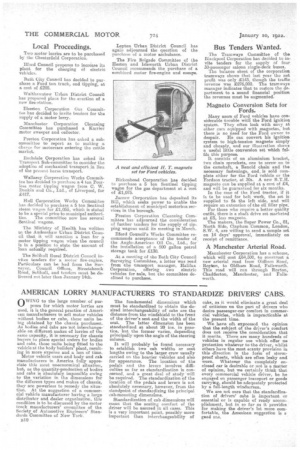AMERICAN LORRY MANUFACTURERS TO STANDARDIZE DRIVERS' CABS.
Page 8

If you've noticed an error in this article please click here to report it so we can fix it.
OWING to the large number of purposes for which motor lorries are used, it is the general practice of American manufacturers to sell motor vehicles without bodies or cabs, these units being obtained by the chassis purchaser. As bodies and cabs are not interchange-. able on different makes of lorries of the same capacity, it is necessary for chassis buyers to place special orders for bodies and cabs, these units being fitted to the vehicle at the body builders plant, resulting in more expense and a loss of time.
Motor vehicle users and body and eels manufacturers in America fully appreciate this most uneconomical situation, but, as the quantity-production of bodies and cabs is absolutely impossible owing to the variation in the dimensions for the different types and makes of chassis, they are powerless to remedy the situation. At the suggestion of a commercial vehicle manufacturer baying a large distributor and dealer organization, this condition is to be discussed by the motor track manufacturers' committee of the Society of Automotive Engineers' Standards Committee of New York, B10 The fundamental dimensions which must be standardized to obtain the desired interchangeability of cabs are the distance from the windshield to the front of the driver's seat and the width of the seat. The latter dimension has been standardized at about 20 ins, in practice, but the former varies, depending principally upon the angle of the steering column.
It will probably be found necessary to establish two cab widths or seat lengths owing to the larger crew usually carried on the heavier vehicles and also for appearance. The location of the pedals and the levers involves difficulties so far as standardization is concerned, and a great deal of study will be required. The standardization of the location of the pedals and levers is not absolutely necessary, however, from the standpoint of standardizing the principal cab-mounting dimensions.
Standardization of cab dimensions will mean that the seating comfort of the driver will be assured in all cases. This is a very important point, possibly more important than interchangeability of
cabs, as it would eliminate a great deal of criticism on the part of drivers who desire passenger-car comfort in commercial vehicles, which is impracticable at the present time.
We have oft expressed the opinion that the subject of the driver's comfort does not receive the consideration that it merits, There are many hundreds of vehicles in regular use which offer no protection whatever to the driver, whilst others have the most scanty provision in this direction in the form of stormproof sheets, which are often leaky and worn. Whatever the completely enclosed car is desirable or not is a matter of opinion, but we certainly think that every commercial vehicle driver, be he engaged on passenger transport or goods carrying, should be adequately protected by a full-length windscreen.
We are not sure that the standardization of drivers' cabs is important or essential Cr is capable of ready accomplishment, but in so far as it provides for making the driver's lot more comfortable, the American suggestion is a good one.


































